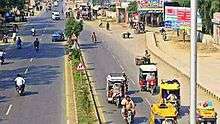Toba Tek Singh
| Toba Tek Singh ٹوبہ ٹیک سنگھ | |
|---|---|
| City | |
|
Shahbaz Chowk | |
 Toba Tek Singh  Toba Tek Singh | |
| Coordinates: 30°58′16″N 72°28′57″E / 30.97111°N 72.48250°ECoordinates: 30°58′16″N 72°28′57″E / 30.97111°N 72.48250°E | |
| Country | Pakistan |
| Province | Punjab |
| Districts | Toba Tek Singh |
| Area | |
| • Total | 3,252 km2 (1,256 sq mi) |
| Elevation | 149 m (489 ft) |
| Population (1998) | |
| • Total | 284,797 |
| • Density | 498/km2 (1,290/sq mi) |
| Time zone | PST (UTC+5) |
| Number of towns | 6 |
| Number of Union councils | 3 |
Toba Tek Singh (Punjabi(Shahmukhi)/Urdu: ٹوبہ ٹیک سنگھ) is a city and tehsil of Toba Tek Singh District in the Pakistani province of Punjab.


History
In the memory of a Sikh saint is enlivened by a city. Before Tek Singh came and lodged here, it was a deserted place by the pond (Toba in the local language). He made it a point to service thirsty passers-by from this pond. Years later, his act of charity founded the city, which is now named after him, Toba Tek Singh.
British Raj
Toba Tek Singh was developed by the British toward the end of the 18th Century when a canal system was built. People from all over the Punjab (currently Indian and Pakistani Punjab) moved there as farmlands were allotted to them. Most of the people who migrated there belonged to Lahore, Jalandhar, Hoshiarpur district. The Imperial Gazetteer of India described the tehsil of Toba Tek Singh as follows:
Tahsil of the new Lyallpur District, Punjab, lying between 30°50' and 31°23' N. and 72° 20' and 72°54' E., with an area of 865 square miles (2,240 km2). The population in 1906 was 148,984. It contains 342 villages, including Toba Tek Singh (population,1,874), the headquarters, and GOJRA (2,589), an important grain market on the Wazirabad -Khanewal branch of the North-Western Railway. The land revenue and cesses in 1905-6 amounted to 4.7 lakhs. The tahsil consists of a level plain, wholly irrigated by the Chenab Canal. The soil, which is very fertile in the east of the tahsil, becomes sandy towards the west. The boundaries of the tahsil were somewhat modified at the time of the formation of the new District of Lyallpur"
After independence
During the 1970s, when many Pakistani cities were renamed to change names given after British Rulers to their original or native names or more acceptable names to local population - for example, Montgomery returned to its original name Sahiwal - Toba Tek Singh remained one of the very few cities to maintain its original name mainly because of reputation of Tek Singh. In 1982 Toba Tek Singh, formerly a subdivision, was separated from Faisalabad District and became a separate district.
Demography
Toba Tek Singh is located in central Punjab and occupies 3252 square kilometres and is made up of large areas of lowlands that flood frequently during the rainy season; the floods originate from the Ravi River that runs along the southern and southeastern borders. The Pre-partition T.T.Singh had a sizeable Sikh population which migrated to Indian Punjab in 1947.
Agriculture productions
Toba Tek Singh is one of the best producers of oranges, locally known as kenno. It contributes towards export standard quality of oranges produced in all Pakistan. The majority of people living in this district work in agriculture and the region produces several kind of agricultural and dairy products, including meat, eggs, cotton, maize, several pulses, peaches, guava, tomato, melon, water melon, mangoes, tobacco, onion.
Notable people
- Mohammad Sarwar, Governor of Punjab, Pakistan, former Member of Parliament (MP)
- Khalil-ur-Rehman Ramday
- Malik Abdul Rasheed(Late)
- Mian Muhammad Latif
- Sardar Muhammad Chaudhry, Inspectors-General of Police, Punjab
- Aasam Mukhtar Chaudhry Tamgah-e-Shujjat (Gallantry)
Education
- Toba Tek Singh has several institutions of higher education including
- Convent Of Jesus And Mary High School
- * Divisional Public School & College (Formerly Jinnah Public High School)
- Govt. Municipal Postgraduate College
- Govt. College of Commerce
- Fauji Foundation Model School
- Govt Islamia Secondary School
- Dar-e-Arqam School
- Govt College for Girls
- Shakila Ghafar National College T.T.S
- Agriculture University sub campus T.T. singh
- جامعہ مسجد عثمانیہ ، اسسٹنٹ کمشنر آفس ٹوبہ ٹیک سنگھ (Jamia Masjid Usmanaia, Assistant Commissioner Office Toba Tek Singh)
- ﺟﺎﻣﻌﻪ ﺭﺑﺎﻧﻴﻪ
- ﺩﺍﺭﺍﻟﻌﻠﻮﻡ ﻋﻴﺪﮔﺎﮦ
- Sultan Foundation School . T.T.Singh
- Islamia Group of colleges Toba Tek Singh
- The Educators (Al Qadir Campus) T.T.S
In popular culture
Saadat Hasan Manto, an Urdu Novelist wrote a short story entitled "Toba Tek Singh" which is a satire on Indo-Pak Partition; in the story, an inmate in an asylum frets over the question of whether his home town Toba Tek Singh is now in India or Pakistan. It was adapted into a short movie of the same name directed by Pakistani filmmaker Afia Nathaniel in 2005.
References
External links
- "The story of Toba Tek Singh"
- Toba Tek Singh on IMDb
- "The official homepage of local government Toba Tek Singh."
- Toba Tek Singh Page on Punjab Govt. website

